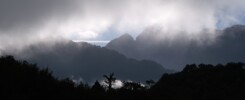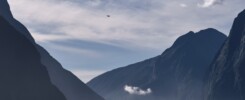Coming to New Zealand from South America almost felt like coming home. Even though we are now on the exact opposite side of the world, pretty remote from pretty much anywhere, we still rediscovered things we had been missing for a while. In addition, the laid-back and welcoming nature of the Kiwis made us feel comfortable very quickly.
Travelling around the world naturally includes crossing the Pacific Ocean, an unfathomably huge stretch of water that takes 14 hours to cross by plane. Unfortunately, we could not go from Santiago to New Zealand directly, but we had a layover in Sydney for 23 hours and 45 minutes until we could board our plane to Auckland. Embarking on a journey of this scale was somewhat frightening and reminded us of the beginning of our tour. In Santiago, we had booked an appartement with a washing machine and a balcony with a drying rack so we could wash our clothes and clean our equipment. Not only had we reached halftime and felt the desire for a little pause for re-organisation, but we had learned that New Zealand immigration is super fussy when it comes to bringing dirty camping equipment and hiking boots. This is why we erected our trusty tent in our Santiago appartement and cleaned it meticulously. The washing machine got fired up nine(!) times and our balcony looked like an outdoor shop with three sleeping bags, three matrasses, and a multitude of shoes drying in the sun. As it turned out, this was well worth the effort.
When we finally reached Santiago airport (the first airport since Rio de Janeiro) and we dropped our clean bags off at the Qantas desk, we felt that something was about to change fundamentally. Number one: language. After three months of feeling like a complete idiot for not being able to communicate successfully due to the language barrier, I was finally able to make meaningful utterances in the form of complete sentences again. When we were waiting at the gate before boarding, the crew strolled by and greeted us cordially. One flight attendant explained in broad Aussie accent that we had a little delay but that we would be ready to board in a few moments. One half of the people listening had a smile on their face while in the other, Spanish speaking half, I mostly saw blank stares. After months of despairingly gazing at people while they were rattling away in Spanish or Portuguese, I felt weirdly relieved.
After 14 hours on a plane with oodles of food and simulated darkness (what time is it anyway, when you cross nine time zones and the international date line?), we landed in hot and windy Sydney. The hotel, albeit very nice and clean, felt like empty space, since we had completely lost track of date and time. Somehow, we managed to sleep at the time we were supposed to, got breakfast in time (full English breakfast makes for excellent brinner), got on the next plane, and made it through immigration including having our tent inspected in the lab. Around midnight, we finally reached our quirky appartement in downtown Auckland. Situated on top of a turn-of-the-century hotel building, we enjoyed not only a remarkable interior design with a layout of three floors with an iron spiral staircase in between, but also an amazing view over the central business district. Sometimes, you get really lucky on Airbnb.
We used our first days in Auckland to settle in, cure our jetlag, and meet Reuben Jelleyman. Anna met Reuben in Vienna in 2019 when he was working with Platypus as an artist in residence. When Anna asked Reuben prior to our tour, whether he wanted to collaborate in his home country, he was happy to not only write a piece for her, but also managed to get Māori musician Ariana Tikao to perform together with Anna in two different music festivals. But this is a story for another post. After a couple of days in Auckland, we rented a car and travelled north.
As always, when we have some time off between concerts and rehearsals, we spend our time camping. And this is where we found another fundamental difference to South America. While Chilean campsites were generally nice and well equipped, the bathrooms usually left a lot to be desired as they were either of faulty design, broken, dirty, or a combination of the above. The facilities at Kiwi campsites are a whole different level as they are designed well, they work as expected, and they are clean. Quite often, we found a fully(!) equipped kitchen with hotplates, oven, microwave, fridge, freezer, etc. And people do clean up after themselves. Yes, everybody cleans the kitchen bench and sink after use. After almost two months in Chile, this blew my mind. What’s more, many campsites in NZ are dog-free. And if there are dogs, they are on a leash and quiet. While Chile is infested with stray dogs in addition to a host of “pet” dogs, and it is perfectly normal for them to defecate everywhere from sidewalks to campsites and playgrounds, and entertain everyone with obnoxious barking 24/7, this seems absolutely inconceivable in this country. Thank God.
I will not go into further detail about all the fantastic campsites, beaches, waterfalls, and hikes we experienced, but I want to share one very special moment with you: Waitangi Day. The national holiday on 6 February marks the signing of a treaty between the Māori and the British and thus the founding of the nation (more info here). It is celebrated around the country, but especially in a place called Waitangi with thousands of Māori congregating on the historical premises for political discussions, prayers, song, dance, and commemoration. The multi-day festival is open to the public and frequented by New Zealanders of any descent and tourists alike, however, it is an occasion for Māori especially to express their political demands. As a response to the political development over the past months, this year’s Waitangi Day was bound to be a particularly important one. This is why we found ourselves among 50,000 people peacefully protesting and celebrating the national holiday in the epicentre of Waitangi. What was really striking was the solemn and calm atmosphere and the orderly coexistence of Māori protesters, spectators, officials, kids, and adults of all walks of life at all times. There was no evidence of violence at all. Imagine this in any other part of the world.
And this is number three of our most striking learnings so far in New Zealand and one of the most prominent differences not only to South America, but to many other places as well: There is a deep appreciation for the indigenous population with Māori culture and language being omnipresent. While colourful song and dance and war canoes sure are impressive tokens of Polynesian culture, it is the culture of debate and mutual respect that makes New Zealand and Māori culture unique and an example for the world to follow. We are looking forward to learning more about this fascinating place, its nature, and its people.








































